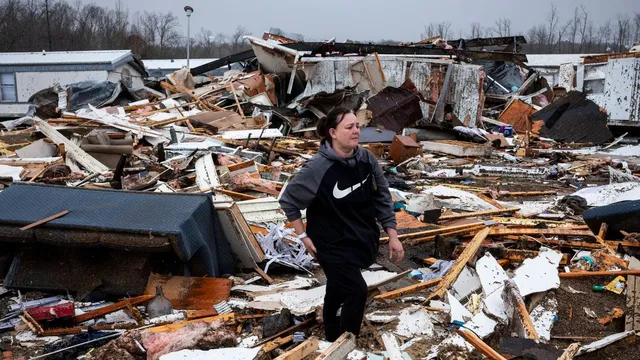
At least 26 killed as violent storms sweep across the country
2025-03-18 00:07- At least 26 people have died as a violent storm system impacts several states, including Missouri and Arkansas.
- The storms have resulted in numerous injuries and extensive damage to homes and infrastructure.
- The rising toll underscores the urgency for communities to remain vigilant and prepared for severe weather.
Express your sentiment!
Insights
In March 2025, a violent storm system impacted the United States, resulting in at least 26 fatalities across multiple states, including Missouri, Arkansas, Kansas, and Texas. The extreme weather was characterized by a combination of tornadoes, severe storms, and dust storms, affecting various regions profoundly. In Missouri alone, at least 12 lives were lost due to powerful tornadoes that destroyed homes and left many areas unrecognizable. In addition to the fatalities caused by tornadoes, a deadly dust storm in Kansas led to a horrific pileup involving over 50 vehicles, claiming eight lives. The storms not only caused loss of life but also destroyed homes and left many individuals injured, with reports of hundreds suffering from storm-related injuries. The storm system also brought about significant power outages, leaving thousands without electricity, while large swaths of land were affected by severe weather conditions, ranging from blizzards in the north to wildfires in the south. With injuries reported in multiple states and extreme weather events jeopardizing safety, officials emphasized the need for preparedness as the storm system continued to push eastward, with further severe weather patterns expected in the upcoming days.
Contexts
Climate change has emerged as one of the most pressing challenges facing humanity, influencing various environmental phenomena, including the frequency and intensity of tornadoes. Tornadoes are complex weather systems, and their formation is highly dependent on specific atmospheric conditions, which can be altered by climate change. While the relationship between climate change and tornado activity is still an area of active research, trends suggest that changing temperatures, increased moisture in the atmosphere, and shifting storm patterns could play a significant role in how tornadoes manifest in the future. Though it is difficult to draw a direct causative link between climate change and tornado frequency, understanding these dynamics is crucial for preparedness and response efforts in vulnerable regions. The frequency of tornadoes varies significantly across different regions and seasons, yet research indicates that climatic changes can lead to alterations in the existing patterns. Warmer air temperatures can increase the amount of moisture the atmosphere holds, which can lead to more intense storms and potentially increase the conditions favorable for tornadoes. Additionally, shifts in jet stream patterns due to climate change may influence storm development, which could contribute to an altered tornado landscape. Some studies suggest that there could be an increase in severe weather events that are conducive to tornado formation, even if the overall number of tornadoes does not drastically increase. Moreover, while individual tornado events are difficult to attribute solely to climate change, the broader trends in storm severity and frequency, as well as the changing landscape of atmospheric conditions, suggest a need for a closer examination of how climatic factors interplay with tornado occurrences. This ongoing research is critical not only for understanding historical data but also for modeling future scenarios under varying climate conditions. This understanding will help in improving forecasting methods and informing emergency management strategies, ultimately saving lives and reducing property damage in affected areas. In conclusion, while conclusively linking climate change to tornado frequency requires more targeted research and data over extended periods, the evidence suggests that changing climatic conditions could influence tornado activity. The evolving nature of this relationship underscores the importance of continued research and monitoring of atmospheric changes. By better understanding these trends, scientists and meteorologists can improve predictive models, leading to enhanced public safety measures and preparedness strategies. As the effects of climate change continue to unfold, the relevance of this research will become increasingly significant for communities at risk of tornadoes.